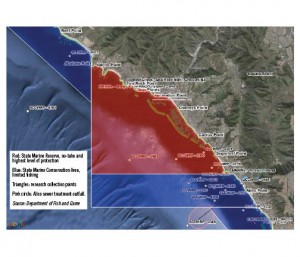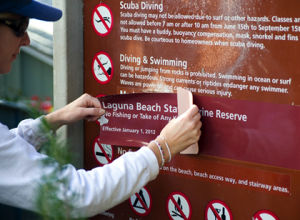
In a win for ocean conservationists, the state Fish and Game Commission earlier this month finalized marine protections for Southern California, preventing fishing or taking anything from the shorline along most of Laguna Beach, effective Jan. 1
Fishermen are adjusting more than their lines to comply with the new order. Volunteers also are stepping up to serve as shoreline sentinels as cash-short state and local regulators have no plans to expand manpower despite broader enforcement responsibilities under the newly enacted mandate.
The conservation zones are part of a network of marine protected areas spanning California’s coast under the decade-old Marine Life Protection Act.
“The science is indisputable that marine life has been overfished. The only way we are ever going to see robust, healthy marine life is protecting the nurseries,” said Laguna resident and ocean-conservation activist Mike Beanan, referring to Laguna’s kelp beds. “This is no different than having national parks.”
Some who draw their livelihood from the sea continue to dispute findings presented during debate over expanding the conservation zones that began in 2008. “The last three years have been disheartening because the fishermen came up with a plan that would be sustainable and the state just disregarded it,” said Josh Fisher, vice president of the California Lobster and Trapfishermen’s Association. The lobster catch is rated by some agencies as sustainable because traps now are required to allow undersize juveniles to escape, resulting in a healthy population not in decline.
An anticipation of the restrictions, last year Fisher relocated his boat from Dana Point Harbor to Redondo Beach and now sells lobster directly to a Santa Monica restaurant and sources other species for resale from fellow fishermen. He predicts many fishermen will be hard hit by the closures.
Laguna Beach’s marine reserve, extending from Irvine Cove to Montage’s Treasure Island Beach, has the highest level of protection, a “no take” zone that prohibits fishing or taking creatures such as mussels and starfish or even pebbles. Two conservation areas, from Irvine Cove to Newport Bay, and from South Laguna’s Sea Cliff Drive to the Dana Point Harbor, will allow recreational fishing, and recreational and commercial urchin and lobster fishing. The area inbetween Treasure Island and Sea Cliff Drive surrounding Aliso Creek and a sewage treatment outfall a mile from shore is also a no-take zone, but has a lower designation to skirt the higher water quality requirements of a marine reserve. Taking anything from any tidepools is also prohibited.
The reserves do nothing to address polluting urban runoff, also a threat to marine ecosystems, point out critics, who are pursuing legal remedies to rollback marine regulations.
Former Laguna mayor Toni Iseman, a member of the South Orange County Wastewater Authority, concedes their point. “If we can take a step forward in one direction, we should do it,” she said.
Studies show more fish and more kelp forests inside the Channel Islands reserve off Santa Barbara than in adjacent areas. Fish populations also flourished in Cabo Pulmo National Marine Park in Mexico between 1999 to 2009, according to a recent Scripps Institute of Oceanography study.

Many hope the Laguna Beach protections will have similar results, though at least lobsterman Rodger Healey predicts a less dramatic increase here because the populations are already healthy. Reviews will be conducted every five years. Fisher hopes lines will be redrawn and he will be able to return to Dana Point.
“When the marine reserve does what it’s supposed to do, increase the marine life, we will definitely have more eco-tourism,” predicted Iseman, though that brings little consolation to fishermen.
Healey, president of a lobster group, recently started importing gear from China to make and repair lobster and crab traps. “But if no one can fish, how is that going to go? I gambled with everything I have to try something new,” said Healey, who intends to stay in the area but shift his trapping farther out, requiring more fuel.
The next battlefront is over enforcement. California’s Department of Fish and Game employed the lowest number of wardens per capita of any state in 2009, the most recent figures available. “We anticipate it’s going to be an additional work load,” said Paul Hamdorf, the assistant chief in Southern California. “If it was for me to determine we’d have a lot more (wardens).”
That’s wishful thinking, says department spokesman Jordan Traverso. “We are in a fiscal crisis and it wouldn’t be a huge shock to have cuts,” he said.
Locally, no discussion is underway over more support for enforcement or public education, Iseman said. Personnel are familiar with the issues as a small no-take reserve was established below Heisler Park years ago, said Marine Safety Chief Kevin Snow. “We haven’t had a call go unanswered that I’m aware of,” he said.
Answering some of those calls is Joy Falk, an animal services officer whose responsibilities include Laguna Woods as well as Laguna Beach. “We’re understaffed as it is,” she said. “Both have a lot of wildlife calls not related to the ocean.”
Most calls reporting violations come from other fishermen or ocean users, she said.
The public can search with a mobile device for protected areas and know if they are currently in one, at the DFG’s mobile website, www.dfg.ca.gov/m/MPA.
In the meantime, the Laguna Ocean Foundation plans to increase funding to hire more tidepool docents that monitor and educate the public at Treasure Island, Heisler Park and Crescent Bay, said board member Louise Thornton.
Ted Reckas is a former Indy staff writer.





[…] “New Ocean Protections Come Ashore”-Laguna Beach Independent, 12-30-2011 […]